Crucial Ballistix Sport XT 1866 MHz 4x4GB Review
 |
Introduction
A system is only as strong as its weakest link, and in many cases (no pun intended) RAM is that weak link. Pairing slow memory with a fast CPU and GPU is going to cause you to lose out of some potential performance. On the other hand, putting super fast memory in a not-so-powerful system is just a waste of money. The important thing is to find that happy medium between price and performance.
Today we are taking a look at Crucial’s happy medium, the Ballistix Sport XT 1866 MHz 4×4 GB kit. The Sport XT offers good speeds, sleek looks, and a fair price. At 1866 MHz there is plenty of speed to get things done, and being a 16 GB kit, you are very unlikely to ever run out of memory again. Read on to see how it performs with our A10-6800k.
 |
 |
Specifications
| Part Number | BLS4K4G3D18ADS3 |
| Density | 16GB (4x4GB) |
| Speed | DDR3-1866 |
| CAS Latency | CL10 (10-10-10-30) |
| Voltage | 1.5V |
| Bandwidth | PC3-14900 |
~
Closer Look
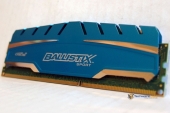 |
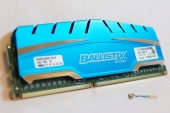 |
The heat spreader on the Ballistix Sport XT has a sleek blue and silver color scheme with fins that aren’t too ridiculous. Seeing as most heat spreaders are more for looks than actual functionality, keeping them a reasonable height is important so that larger air coolers still fit.
 |
Benchmarks
Test System
- AMD A10-6800k
- ASRock FM2A85X Extreme 6
- Corsair H100
We decided to test the memory using just the 6800k with no discrete GPU to demonstrate the improvements faster memory has on these new APUs. The memory was tested at stock speed and then downclocked to 1600 and 1333 MHz to compare the results.
CPUZ
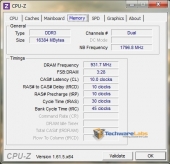 |
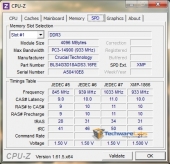 |
In CPU-Z we see that our memory is clocked at 1866 MHz with the timing set at the stock 10-10-10-30 at 1.5v. The timing on this memory is quite loose compared to similar kits which are around 9-10-9-28 at the same voltage.
3DMark
 |
 |
 |
| 1333 MHz | 1600 MHz | 1866MHz |
The new 3DMark benchmark stresses both the GPU and CPU heavily and should show a significant gain from increased memory speeds.
At the downclocked 1333 MHz our Ballistix allowed the 6800k to score a 5043 in the Cloud Gate benchmark and 823 in Fire Strike. Bumping the speed to a still downclocked 1600 MHz gave us a 10-11% increase and finally bringing the RAM to the stock 1866 MHz speed gave us an extra 6-7%. Simply increasing our memory speed netted us around a 17% increase overall which is quite significant.
3DMark 11
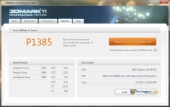 |
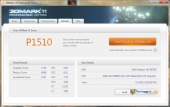 |
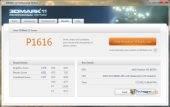 |
| 1333 MHz | 1600 MHz | 1866MHz |
3DMark 11, like the new 3DMark, stresses both CPU and GPU, focusing specifically on DirectX 11 features.
Our score of 1385 at 1333 MHz increased to 1510 at 1600 MHz, giving us an 8% gain. Bumping the speeds to the stock 1866 increased our score 14% over 1333, giving us a final score of 1616.
Unigine Heaven
 |
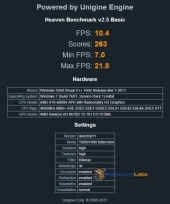 |
 |
| 1333 MHz | 1600 MHz | 1866MHz |
Unigine Heaven is a graphically intensive DirectX 11 benchmark that heavily stresses the GPU as well as the CPU.
At 1333 MHz our average fps was 9.2. Increasing the speeds to 1600 bumped that average up to 10.4, and finally bringing it to the stock 1866 we were able to pull 11.6 fps. Now this might now seem like much considering the fps itself is so low, but comparing the numbers to each other we see that increasing our RAM speed from 1333 to 1866 gave us a massive 20% increase.
DiRT 3
 |
 |
 |
| 1333 MHz | 1600 MHz | 1866MHz |
DiRT 3 represents a mid-level graphically intensive game which we ran at the high preset.
Our 6800k with memory clocked at 1333 MHz was able to pull an average fps of 22.7. Jumping up to 1600 MHz added another 3.5 fps and moving up to 1866 added another 2.8 fps to our average. Going from the downclocked 1333 MHz to the stock 1866 MHz netted us an impressive 21% increase.
Bioshock Infinite
 |
Bioshock Infinite is the newest title in the popular Bioshock series and is fairly graphically intensive. We ran the built-in benchmark at the Ultra preset.
Although the 6800k struggled at such a high preset without a discrete GPU, we can clearly see that as the memory speed increased the fps increased as well. Going from 1333 MHz to 1866 we see a 16-17% increase to both our average and minimum fps.
 |
Final Thoughts
All in all, the Crucial Sport XT’s performed beautifully when paired with the 6800k. We can clearly see that these APUs benefit hugely from increased memory speeds, often giving boosts of around 20% in real-life applications from 1333 MHz to 1866 MHz. But you must realize, the results obtained here, while relevant for the AMD APUs, are not going to directly translate over to a different system. Other systems may not see as much of a gain from increasing memory speeds.
Having said that, the Sport XT’s are a worthwhile investment for someone looking to upgrade their memory. At 1866 MHz there is plenty of speed to get things done quickly, and being a 16 GB kit, running out of memory should be a thing of the past. The only issue I have with this kit is that at 10-10-10-30, the timing is a little looser than comparable kits. But at around $150, it is also one of the most inexpensive 1866 MHz 4×4 GB kits you can buy. If you are looking for fairly powerful RAM that won’t break the bank, the Sport XT’s would be a good choice.
 |

[…] Crucial Ballistix Sport XT 1866 MHz 4x4GB Review @ TechwareLabs […]
[…] Crucial Ballistix Sport XT 1866 MHz 4x4GB Review @ TechwareLabs.com […]
[…] Crucial Ballistix Sport XT 1866 MHz 4x4GB Review @ TechwareLabs.com […]
[…] Crucial Ballistix Sport XT 1866 MHz 4x4GB Review @ TechwareLabs.com […]